Economy Keeps Salaries Flat
Compensation appears to have plateaued, but most food scientists find much satisfaction in their jobs, according to the 2011 IFT Membership Employment & Salary Survey.
 The median salary for U.S.-based members of the Institute of Food Technologists has leveled off over the past two years, according to the 2011 IFT Membership Employment & Salary Survey conducted this past fall. For 2011, the median salary for survey respondents was $87,000, a slight drop of 0.8% compared with the 2009 IFT member median of $87,700. (See Table 1 for an overview of 2011 survey data compared with 2009 data and Table 2 for more details on 2011 median salaries and bonuses.)
The median salary for U.S.-based members of the Institute of Food Technologists has leveled off over the past two years, according to the 2011 IFT Membership Employment & Salary Survey conducted this past fall. For 2011, the median salary for survey respondents was $87,000, a slight drop of 0.8% compared with the 2009 IFT member median of $87,700. (See Table 1 for an overview of 2011 survey data compared with 2009 data and Table 2 for more details on 2011 median salaries and bonuses.)  With the U.S. economy flagging since the recession began in December 2007 and the national unemployment level hovering close to 9% for much of 2011 (USBLS, 2012), the minor dip in IFT member salaries—a blip in what has historically been a steady upward trend—is hardly surprising, say employment and compensation experts.
With the U.S. economy flagging since the recession began in December 2007 and the national unemployment level hovering close to 9% for much of 2011 (USBLS, 2012), the minor dip in IFT member salaries—a blip in what has historically been a steady upward trend—is hardly surprising, say employment and compensation experts.
 “I’ve noticed a small contraction [in employment opportunities/compensation],” observed John Scerbo, President of FoodEmployment.com, a Roscoe, Ill.-based executive search firm for food industry professionals. “I think some of it is caused by the quantity of unemployed people.”
“I’ve noticed a small contraction [in employment opportunities/compensation],” observed John Scerbo, President of FoodEmployment.com, a Roscoe, Ill.-based executive search firm for food industry professionals. “I think some of it is caused by the quantity of unemployed people.”
When job seekers have been out of work for a while, they typically re-enter the workforce at a lower salary, said Scerbo. “I see some companies making lower offers because of people being unemployed. And that’s going to affect the overall average.” In fact, Scerbo continued, “I’ve had two candidates in the past few months reject offers. Both were unemployed, and the offers were so low they rejected them.”
--- PAGE BREAK ---
Although the recession officially ended in 2009, the lingering climate of economic uncertainty plays a role in depressing salaries, said recruiter Tim Oliver, President of Optimum Search Inc., which has offices in Atlanta, Ga., and Holly Springs, N.C. “I get the impression from our clients that business is pretty good,” said Oliver, “but they all seem to be fearful of what’s next.” Thus, he theorized, there’s a prevailing mindset within many companies that “we’ve got to operate from the thinnest margins possible, and we can’t veer from it.”
That can make it challenging for corporate hiring personnel seeking to fill a position—not to mention less than optimal for job seekers. “Those decrees come from the top—from the guys who are crunching the numbers,” Oliver said.
“The economy does impact hiring,” said executive recruiter Maxine Horowitz, owner of Delray Beach, Fla.-based MDH Search, but it’s mostly internal equity issues that determine salary ranges. “Often they [employers] will give a bonus to get someone,” Horowitz said, “but these days, they are pretty regulated by the company’s guidelines for a particular pay grade.”
“It’s not a matter of their [prospective employees’ value, it’s a matter of company parity—i.e., we’re paying seven people at grade 21 between X and Y, [so] we have to pay you between X and Y,” agreed recruiter/human resources (HR) consultant Ron Bynum, President of Daytona Beach, Fla.-based RightSource Inc. Corporate HR requirements for positions are often so buttoned down that once-common tactics like bargaining for an extra week of vacation time are becoming harder for job seekers to pull off, said Bynum.
Employers aren’t offering as much to attract candidates, Bynum continued. “A few years ago, increases were averaging 10% to 15% of base salary,” the recruiter claimed. “Now I see increases averaging 5% to 10% with maybe a sign-on bonus or a chance to share in the profits. The raises to change jobs have gone down a little bit, which goes along with the recession.”
Bynum’s assessment is accurate, according to Jennifer Schramm, Manager, Workplace Trends and Forecasting for the Society for Human Resource Management (SHRM), an Alexandria, Va.-based association for HR professionals that conducts extensive research on employment conditions and employee benefits. In 2009, the compensation for new hires was trending downward for many months—an unusually negative scenario, Schramm said. Since then, she explained, it’s been inching back up, but at an extremely gradual rate.
--- PAGE BREAK ---
“These are such small percentages,” said Schramm, “that the majority of our organizations say that they’re just keeping everything the same.”
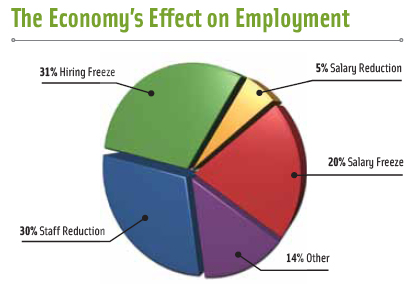 Asked how the economic climate has affected their workplace, 31% of the IFT salary survey respondents cited a hiring freeze, 30% a staff reduction, and 20% a salary freeze (Figure 1).
Asked how the economic climate has affected their workplace, 31% of the IFT salary survey respondents cited a hiring freeze, 30% a staff reduction, and 20% a salary freeze (Figure 1).
The IFT survey statistics on hiring freezes appear to be consistent with those tracked in other industries. According to SHRM data (2010, 2011a), about 34% of organizations across all industries had hiring freezes in 2009, and nearly 21% reported hiring freezes in 2010. (SHRM does not track salary freezes.)
Gender Salary Gaps
One recurring theme in IFT salary surveys is the existence of a substantial salary differential between male and female respondents. In 2011, the median salary for female survey respondents was $77,812—nearly 22% less than the median of $99,250 for male survey participants. The salary gap has narrowed a bit over the years. In 1993, women earned 30% less than men—a median of $42,000 compared with $60,000 for men. (See Figure 2 for an historical perspective on salaries according to gender.)
Moira McGrath, President of Deerfield Beach, Fla.-based OPUS International, said she hasn’t encountered gender-based salary discrepancies in her work as a recruiter. “I really haven’t seen that at all,” said McGrath. “When I’m given a job opening, and they say the salary is $80,000 to $90,000, I’m not seeing that the women are getting $80,000 and the men $90,000.”
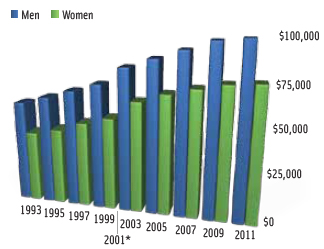 Recruiter Bynum, on the other hand, believes the gender salary differential is a reality—but not necessarily to the extent the IFT survey indicates. “Women are still somewhat underpaid in the food area compared to men,” said Bynum. But, he added, “Women have made tremendous strides in management in the past five to 10 years. Most companies that I go to, that mid-level R&D manager is a woman.
Recruiter Bynum, on the other hand, believes the gender salary differential is a reality—but not necessarily to the extent the IFT survey indicates. “Women are still somewhat underpaid in the food area compared to men,” said Bynum. But, he added, “Women have made tremendous strides in management in the past five to 10 years. Most companies that I go to, that mid-level R&D manager is a woman.
--- PAGE BREAK ---
“I think the salaries are catching up,” Bynum continued. “I think the payment differential is really closer to 8% to 10%. I see more differential in salary based on location and cost of living than I see on gender or even degree.”
Breaking out survey data by age group and gender also provides reason for optimism that the salary gap between women and men may be closing. Men in every age bracket outearn women except for those in the age range of 20–29. For this age group, the median salary is $55,000 for both men and women.
According to the 2011 IFT salary survey, median salaries were highest in the South Atlantic region (which extends from West Virginia to Florida), where the median was $100,000, and lowest in the Other Pacific region (which includes Washington, Oregon, Alaska, and Hawaii) at $72,500.
IFT salary survey data also shows men outpacing women in terms of cash bonuses and stocks. For men, the median cash bonus was $10,000; for women, it was $6,000. For the relatively small group that received them, the median stock award for men was $10,000, while for women it was $5,900.
A Matter of Degrees
What about advanced degrees? There’s no doubt that master’s and doctoral degrees are required for positions in academia, but do they pay off for those seeking to snag industry jobs? That’s not so clear-cut, according to the recruiters.
“I don’t notice a lot of difference in salaries with advanced degrees,” said Bynum. “I typically don’t see much of a pay differential—maybe $2,000 or $3,000 for an M.S. or an M.B.A.
“Get that five years of experience,” he counseled. “You may find that [experience] and personality gets you just as far.”
M.B.A.s are far from guaranteed salary boosters—unless they come from a very elite school, Bynum continued. “A Harvard M.B.A. is great,” he said.
--- PAGE BREAK ---
“I do see a difference between a bachelor’s and a Ph.D.,” said Scerbo, adding that “there’s going to be a difference in terms of starting salaries.” But, he continued, sometimes that salary differential is minimal for those who have been in the workplace for a while. “I place people with a bachelor’s degree who may be making more money than people with a Ph.D. Once you’re in an organization and prove yourself, most people are going to promote the people who are making a contribution.”
According to 2011 IFT salary survey data, the median salary for respondents with a bachelor’s degree was $80,000. For an M.S. degree, it was $85,000; for an M.B.A., $105,000; and for a Ph.D., $105,000.
Who’s in Demand
What skill sets are most sought after by food industry employers? “We’re seeing quite a bit [of opportunity] in nutrition science and food safety,” said McGrath. “I would say those are the two main areas—nutrition being much more important these days because the customers are demanding it. But food safety is No. 1.”
“The nutrition area has gotten very, very important in the last few years with all the emphasis on obesity and sodium reduction,” said Horowitz. “This is an overarching trend. Companies are really, really focusing on reformulating products so that they are healthier.”
“What we’ve seen from a growth perspective is nutritional/nutraceutical … that tends to be a hotter area,” said Bynum. “And some of the smaller companies are paying above average to get the expertise they need.”
“The bottom line is that in order for companies to continue to grow their business, there has to be new product development, and science is always going to be important,” Horowitz summarized. “But what also is important is someone who has really good interpersonal skills because there is so much interaction with sales and marketing and other departments. They have to be well rounded. Even someone who is a Ph.D. and doing research has to be able to communicate his or her findings to other departments.”
--- PAGE BREAK ---
On the job, it’s particularly important for R&D and other food science professionals to be able to effectively communicate scientific issues to senior-level management. “Translating scientific insights for non-scientists requires a special set of communication skills, including the ability to break down complex concepts into more easily digestible key points,” McGrath pointed out. “It’s critical for food scientists to hone these skills in order to ensure that corporate product development and food safety initiatives get support from the upper echelons of an organization.”
What Matters Most 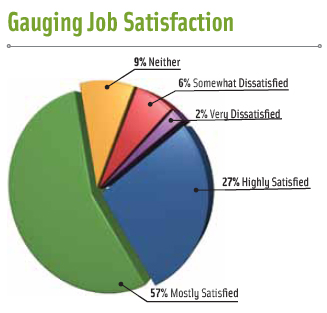 It’s not all about financial compensation, of course. This year for the first time, the IFT Employment & Salary Survey asked participants to weigh in on issues ranging from job satisfaction to sources of stress in the workplace, and the majority had positive things to say about their profession.
It’s not all about financial compensation, of course. This year for the first time, the IFT Employment & Salary Survey asked participants to weigh in on issues ranging from job satisfaction to sources of stress in the workplace, and the majority had positive things to say about their profession.
More than eight out of 10 (84%) said they are either mostly satisfied (57%) or highly satisfied (27%) with their jobs (Figure 3). It is clear that food scientists are driven by a desire for intellectual stimulation; more than half of survey respondents (51%) ranked it as the factor that contributes most to job satisfaction, with job security (23%) and opportunity to advance (11%) in fairly distant second and third place positions (Figure 4).
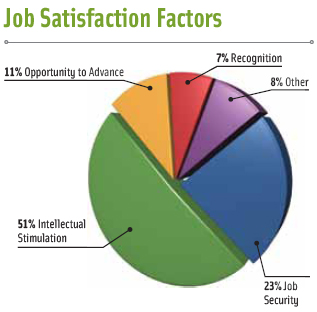 So perhaps it’s no surprise that the variety and unpredictability of the workday are factors that many respondents cited when asked what they enjoy most about working in the field of food science. “The challenges are always new. I have never had two days that are exactly the same in 48 years as a food scientist/manager/company owner,” said one industry veteran. “I enjoy working in an environment that is constantly changing with new information to learn around every corner,” another noted. “It is an evolving field. There is always something new to learn or a new challenge to face,” another respondent observed.
So perhaps it’s no surprise that the variety and unpredictability of the workday are factors that many respondents cited when asked what they enjoy most about working in the field of food science. “The challenges are always new. I have never had two days that are exactly the same in 48 years as a food scientist/manager/company owner,” said one industry veteran. “I enjoy working in an environment that is constantly changing with new information to learn around every corner,” another noted. “It is an evolving field. There is always something new to learn or a new challenge to face,” another respondent observed.
--- PAGE BREAK ---
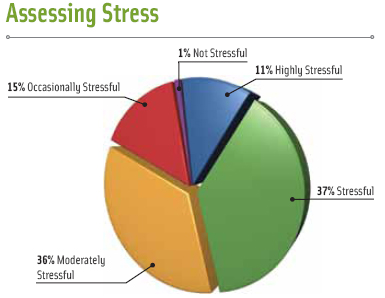 That’s not to say that life on the job is consistently worry-free. Almost three-quarters of respondents (73%) characterized their jobs as stressful (37%) or moderately stressful (36%), and another 11% said their jobs were highly stressful (Figure 5).
That’s not to say that life on the job is consistently worry-free. Almost three-quarters of respondents (73%) characterized their jobs as stressful (37%) or moderately stressful (36%), and another 11% said their jobs were highly stressful (Figure 5).
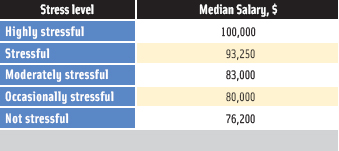 But job-related stress has its upside; the IFT survey shows a direct correlation between stress and salary. Survey respondents who characterized their jobs as highly stressful had a median salary of $100,000, those who called their jobs stressful earned a median of $93,250, and those who said the job was moderately stressful reported a median salary of $83,000, while the median salary for those who labeled their jobs as not stressful was $76,200. (See Table 3 for a full breakout of the stress/salary correlation.)
But job-related stress has its upside; the IFT survey shows a direct correlation between stress and salary. Survey respondents who characterized their jobs as highly stressful had a median salary of $100,000, those who called their jobs stressful earned a median of $93,250, and those who said the job was moderately stressful reported a median salary of $83,000, while the median salary for those who labeled their jobs as not stressful was $76,200. (See Table 3 for a full breakout of the stress/salary correlation.)
Survey respondents who said they were highly satisfied with their job also earned the most—a median salary of $96,000 vs $85,000 for those who were mostly satisfied and $79,000 for the neutral segment, i.e., neither satisfied nor dissatisfied.
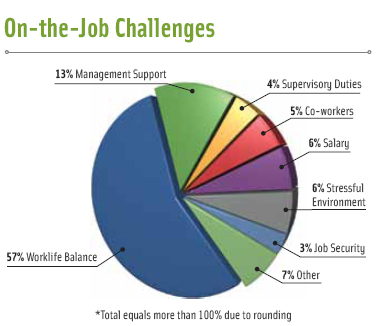 Workload and achieving work/life balance lead the list of workplace challenges, cited by 57% of those who responded to the question, “What is the biggest challenge you face on the job?” That total was far ahead of the second-most-cited challenge, which was management support, mentioned by 13%. (See Figure 6 for insights into what else respondents find challenging about their jobs.)
Workload and achieving work/life balance lead the list of workplace challenges, cited by 57% of those who responded to the question, “What is the biggest challenge you face on the job?” That total was far ahead of the second-most-cited challenge, which was management support, mentioned by 13%. (See Figure 6 for insights into what else respondents find challenging about their jobs.)
--- PAGE BREAK ---
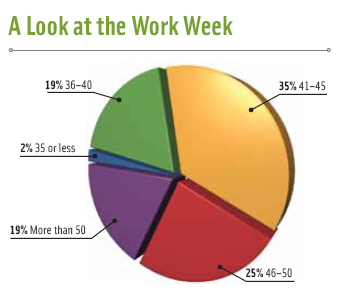 What’s the average work week for survey respondents? The largest segment (35%) reported working 41–45 hours weekly, followed by 25% who work an average of 46–50 hours. In addition, 19% said they work more than 50 hours a week. (See Figure 7 for more statistics on work hours per week.)
What’s the average work week for survey respondents? The largest segment (35%) reported working 41–45 hours weekly, followed by 25% who work an average of 46–50 hours. In addition, 19% said they work more than 50 hours a week. (See Figure 7 for more statistics on work hours per week.)
Logging lots of hours can pay financial dividends, the survey suggests. When salaries were broken out by hours worked, the highest median salary ($110,000) belonged to those who reported working more than 50 hours a week. The second-highest median salary in the salary-by-hours-worked breakout was $95,000, which went to those who work 46–50 hours a week. Those who work 35 hours a week or less earned a median of $76,000.
How Benefits Are Changing
Has the troubled economy affected employee benefits? SHRM research shows that it has, and IFT’s survey provides some similar indications.
“We’ve asked organizations if benefit offerings have been affected by the economy, and about 65% said to some extent and 12% said to a large extent,” (SHRM, 2011b) said S. Evren Esen, Manager of SHRM’s Survey Research Center.
“What we’re seeing more of—and it’s the general trend we’ve seen over the past several years—is that employers are putting more of the onus on employees to take responsibility for their benefits,” said Esen. For example, she explained, more and more employers are moving away from defined benefit plans such as pension plans to contribution plans like a 401k or an IRA (individual retirement account).
IFT survey statistics show a relatively steep downturn in the availability of pension plans. In the 2011 survey, the percentage of respondents who said their company offers a pension was 32% compared with 39% in 2009 and 44% in 2007.
--- PAGE BREAK ---
That’s consistent with the trend SHRM research has identified, although IFT survey respondents tend to be a bit more fortunate than most when it comes to pensions. According to SHRM data, 40% of organizations offered defined pension plans in 2007, but by 2011, that total had dropped to 22% (SHRM, 2011b).
In general, Esen said, employers are offering fewer of the fun, creative benefits like in-house massages or executive club memberships. “This isn’t a time when we’re seeing a lot of innovation in the types of benefits that employers are offering,” she said.
Perhaps because of the role they can play in promoting employee health and wellness, however, fitness facility fees were covered by 40% of IFT survey respondents—the same percentage as in 2009 and 2011.
The 2011 survey found 35% of respondents reporting the availability of flex time at their respective companies, down from 37% who had flex time in 2009, and 39% who reported it in 2007.
 SHRM encourages employers to embrace the concept of flexibility—be it in the form of flex-time work schedules, telecommuting, or sabbaticals, among many other options. In this era of austerity, it’s an opportunity to provide a benefit that is relatively low-cost, but can be a huge draw for prospective employees, Esen noted. (See Table 4 for more details on benefits IFT survey respondents reported).
SHRM encourages employers to embrace the concept of flexibility—be it in the form of flex-time work schedules, telecommuting, or sabbaticals, among many other options. In this era of austerity, it’s an opportunity to provide a benefit that is relatively low-cost, but can be a huge draw for prospective employees, Esen noted. (See Table 4 for more details on benefits IFT survey respondents reported).
Better Days Ahead?
The U.S. employment picture got a bit rosier as 2011 drew to a close. The 8.5% U.S. unemployment rate for December 2011, reflects a decline of 0.6% since August 2011 (USBLS, 2012), and heading into the new year, food industry recruiters seem cautiously optimistic.
--- PAGE BREAK ---
“At the end of the day, people still have to eat—good economy or bad economy,” said Scerbo. “Most of my clients are doing pretty well. It goes up and down in this industry, but the bottom line is, it is still stable.”
McGrath said her business was strong in 2011, and early indications are that it will continue that way in 2012. “I would say that overall the reason for the uptick in 2011 was that after the staff reductions in 2009 and 2010, food companies realized that they could not continue in that way and be able to grow. They knew they needed to put people in food safety positions and that if they did not innovate in product development, they would not be competitive,” she said.
Horowitz has a similar perspective. “I think people are starting to cautiously ramp up because they’ve held back for so long,” she said. “As people’s businesses are growing and they’re feeling a little more optimistic, they’re starting to fill in the [hiring] gaps.” And that is good news for everyone.
Smart Strategies for on-the-Job Success
There’s more to advancing your career—and increasing your salary—than working hard and doing a good job. Those are requirements, of course, but achieving professional success doesn’t stop there.
IFT President-Elect John Ruff, a former Kraft Foods Senior Vice President, likened the process of building and sustaining a successful career to the growth cycle of a tree. Consider the following recommendations from Ruff and other career development experts.
• Establish a firm foundation. “Think of building your career like a tree growing,” said Ruff. “First, a sapling puts roots into the ground, often the deeper the better. So start your career by building on your education and developing an area of expertise on the job. Become known for your skill in this area and for making a difference.”
• Take the initiative. After a tree takes root, it begins to spread its branches, said Ruff, continuing the metaphor. “So you should broaden your experiences initially with different scientific job assignments and later by gaining experience in another functional area and/or country.”
• Give a little. “Eventually, a fully grown tree provides shade,” said Ruff. “So you should mentor new professionals, recalling both your successes and failures. You will be surprised how much you can learn from your mentees; upward mentoring works too!”
--- PAGE BREAK ---
• Be an effective communicator and advocate for science. Not everyone within a food company—including top management—will understand the value and impact of incorporating a food science perspective into key decision-making processes. Developing the communication skills required to share this perspective when interacting with other departments in the organization and communicating with senior management can help you advance your career and ensure that the organizational strategy is informed by scientific insight, noted Moira McGrath, President of executive recruitment company OPUS International.
• Take a calculated risk. “The most important attribute for success is a willingness to try and, hence, fail sometimes,” counseled Ruff. “Remember, ball players miss 100% of the shots they don’t attempt.”
• Stay connected. “Building a credible network of industry contacts is absolutely critical if one is concerned about his or her career long-term,” said John Scerbo, President of FoodEmployment.com.
To that end, he advises food industry professionals to keep current using business-oriented social networking sites like the IFT Online Community and LinkedIn. In addition, niche job boards can be beneficial sources of industry news and job opportunities.
But don’t overlook the importance of participating in “non-virtual” networking as well. Attend IFT’s Annual Meeting & Food Expo each year, for example. Not only will it provide insights likely to be valuable in the workplace, it can help ensure that you have a network of professional contacts in place if you find yourself looking to make a job change. “Those people that are well networked, those are the people who are going to find jobs quickly,” said Scerbo.
Advice from the Experts
Wouldn’t it be great to tap into the collective wisdom of some of the food industry’s leading executive recruiters? Here’s an opportunity to do just that. Check out this list of dos and don’ts for job seekers courtesy of executive recruiters Ron Bynum, Maxine Horowitz, Moira McGrath, and John Scerbo.
• Do customize your resume. Don’t limit yourself to a one-size-fits-all approach to resume preparation. To the extent that you can, tailor it to highlight the ways in which your skills and experience match those that an employer is seeking. “The document is so important,” said Bynum. “It’s so important to have it accurate, but to modify it for each position you are applying for.”
--- PAGE BREAK ---
• Don’t overshare. The biggest mistake that job hunters make, according to Bynum, is volunteering too much personal information during an interview. Once you’re established in a workplace, many employers will make accommodations to help you address challenges like dealing with elderly parents or a special needs child, but it’s not a good idea to share that kind of information too early on in the interview process, said Bynum.
Of course if you’re going to need a flexible schedule in order to pick up your child before daycare closes, for example, do arrange for that before accepting a job. But don’t introduce such topics before you know if you’ll be receiving a job offer.
• Do go into the interview with energy and enthusiasm. Employers love a can-do attitude. Presenting yourself as a doer is critical, said Horowitz, “because, in the end, chemistry with the leadership is often the deciding factor, especially if they feel you will fit into their culture.”
• Don’t be overconfident. Self-confidence is a plus, but if you come across as excessively sure of yourself, the company may see you as someone who is not a team player and who may be difficult to manage, Horowitz counseled.
• Do try to be open to relocating. “The perfect job may not be in your perfect location, but if it gives your career a boost, you should consider it,” Horowitz advised.
• Don’t limit yourself. “It’s in your best interest to use every resource available, and that may include working with multiple recruiters,” said Scerbo. “The truth of the matter is that every recruiter has relationships with different companies. I would tell applicants, work with 10 specialty recruiters, and work with niche recruiters within the industry because they’re the ones that are going to have the relationships.”
• Do educate yourself. Read the Martin Yate book, Knock ‘em Dead: The Ultimate Job Search Guide (Adams Media, 2011). Bynum said it’s one of the best resources around for job seekers and a sure way to “avoid the land mines” that can be part of the interview process.
--- PAGE BREAK ---
• Don’t send your resume to blind ads. “They only go to a black abyss,” said McGrath. “Most of them are teaser ads without a real job behind them.”
• Do follow up. Send thank-you notes promptly either via mail or e-mail. “This is not only the polite thing to do,” said McGrath, “but it is effective in having the company remember you more fondly and as a professional.”
Tap into IFT’s Career Center Resources
Job seekers have free access to the best employers and jobs in food science and technology through the IFT Career Center. They can browse job postings, receive e-mail notifications when new jobs are listed, and post their resumes. Employers can register to find the most talented and qualified candidates for their job openings. For more information, click on “Career Center” on IFT’s website, www.ift.org.
Get the Full Salary Survey Report
Are you interested in accessing detailed data on IFT member compensation, including breakouts of salaries by geographic region, job function, years of employment, and much, much more? This year, for the first time, IFT is offering supplemental information in the form of the 2011 Membership Employment & Salary Survey Report. In addition to numerous charts and tables, the report features commentary on the salary survey findings. It is available free of charge to IFT members and to nonmembers for $99. For more information or to download the report, go to ift.org/salaryreport.
Survey Methodology
A total of 1,923 IFT members—or about 18% of those U.S. IFT members with valid e-mail addresses—responded to the 2011 Employment & Salary Survey, which was conducted in October and November. E-mail invitations provided instructions on how to access a 40-question survey on the Internet. Results, which were tabulated by Data Lab Corp., Niles, Ill., were kept completely anonymous and confidential. Respondents divided evenly along gender lines—50% were male and 50% female.
When reviewing the data presented in this article, readers should note that percentages may add up to more or less than 100% because of rounding.
Mary Ellen Kuhn is Managing Editor of Food Technology magazine
([email protected]).
References
SHRM. 2010. Human capital benchmarking database. Society for Human Resources Management, Alexandria, Va. www.shrm.org.
SHRM. 2011a. Human capital benchmarking database.
SHRM. 2011b. 2011 Employee benefits: Examining employee benefits amidst uncertainty.
USBLS. 2012. Employment situation summary. Economic news release, Jan. 6. U.S. Bureau of Labor Statistics, Washington, D.C. www.bls.gov.
